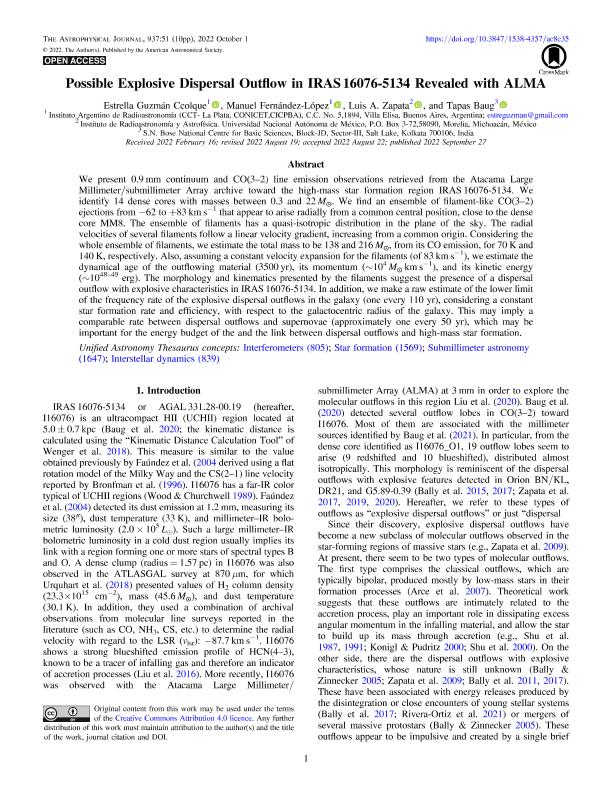Mostrar el registro sencillo del ítem
dc.contributor.author
Guzmán Ccolque, Estrella

dc.contributor.author
Fernandez Lopez, Manuel

dc.contributor.author
Zapata, Luis A.
dc.contributor.author
Baug, Tapas
dc.date.available
2023-11-10T15:19:43Z
dc.date.issued
2022-10
dc.identifier.citation
Guzmán Ccolque, Estrella; Fernandez Lopez, Manuel; Zapata, Luis A.; Baug, Tapas; Possible Explosive Dispersal Outflow in IRAS 16076-5134 Revealed with ALMA; IOP Publishing; Astrophysical Journal; 937; 2; 10-2022; 1-10
dc.identifier.issn
0004-637X
dc.identifier.uri
http://hdl.handle.net/11336/217772
dc.description.abstract
We present 0.9 mm continuum and CO(3-2) line emission observations retrieved from the Atacama Large Millimeter/submillimeter Array archive toward the high-mass star formation region IRAS 16076-5134. We identify 14 dense cores with masses between 0.3 and 22 M ☉. We find an ensemble of filament-like CO(3-2) ejections from −62 to +83 km s−1 that appear to arise radially from a common central position, close to the dense core MM8. The ensemble of filaments has a quasi-isotropic distribution in the plane of the sky. The radial velocities of several filaments follow a linear velocity gradient, increasing from a common origin. Considering the whole ensemble of filaments, we estimate the total mass to be 138 and 216 M ☉, from its CO emission, for 70 K and 140 K, respectively. Also, assuming a constant velocity expansion for the filaments (of 83 km s−1), we estimate the dynamical age of the outflowing material (3500 yr), its momentum (∼104 M ☉ km s−1), and its kinetic energy (∼1048-49 erg). The morphology and kinematics presented by the filaments suggest the presence of a dispersal outflow with explosive characteristics in IRAS 16076-5134. In addition, we make a raw estimate of the lower limit of the frequency rate of the explosive dispersal outflows in the galaxy (one every 110 yr), considering a constant star formation rate and efficiency, with respect to the galactocentric radius of the galaxy. This may imply a comparable rate between dispersal outflows and supernovae (approximately one every 50 yr), which may be important for the energy budget of the and the link between dispersal outflows and high-mass star formation.
dc.format
application/pdf
dc.language.iso
eng
dc.publisher
IOP Publishing

dc.rights
info:eu-repo/semantics/openAccess
dc.rights.uri
https://creativecommons.org/licenses/by-nc-sa/2.5/ar/
dc.subject
Interferometers
dc.subject
Star formation
dc.subject
Submillimeter astronomy
dc.subject
Interstellar dynamics
dc.subject
Astrophysics - Astrophysics of Galaxies
dc.subject
Astrophysics - Solar and Stellar Astrophysics
dc.subject.classification
Astronomía

dc.subject.classification
Ciencias Físicas

dc.subject.classification
CIENCIAS NATURALES Y EXACTAS

dc.title
Possible Explosive Dispersal Outflow in IRAS 16076-5134 Revealed with ALMA
dc.type
info:eu-repo/semantics/article
dc.type
info:ar-repo/semantics/artículo
dc.type
info:eu-repo/semantics/publishedVersion
dc.date.updated
2023-11-10T14:34:46Z
dc.journal.volume
937
dc.journal.number
2
dc.journal.pagination
1-10
dc.journal.pais
Reino Unido

dc.description.fil
Fil: Guzmán Ccolque, Estrella. Provincia de Buenos Aires. Gobernación. Comisión de Investigaciones Científicas. Instituto Argentino de Radioastronomía. Consejo Nacional de Investigaciones Científicas y Técnicas. Centro Científico Tecnológico Conicet - La Plata. Instituto Argentino de Radioastronomía; Argentina
dc.description.fil
Fil: Fernandez Lopez, Manuel. Provincia de Buenos Aires. Gobernación. Comisión de Investigaciones Científicas. Instituto Argentino de Radioastronomía. Consejo Nacional de Investigaciones Científicas y Técnicas. Centro Científico Tecnológico Conicet - La Plata. Instituto Argentino de Radioastronomía; Argentina
dc.description.fil
Fil: Zapata, Luis A.. Instituto de Radioastronomía y Astrofísica; México
dc.description.fil
Fil: Baug, Tapas. S N Bose National Centre For Basic Science; India
dc.journal.title
Astrophysical Journal

dc.relation.alternativeid
info:eu-repo/semantics/altIdentifier/doi/http://dx.doi.org/10.3847/1538-4357/ac8c35
Archivos asociados
